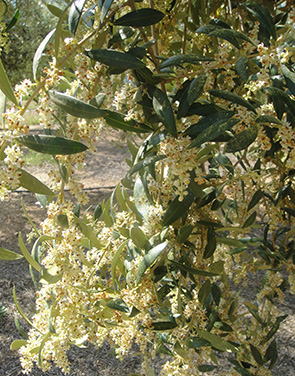


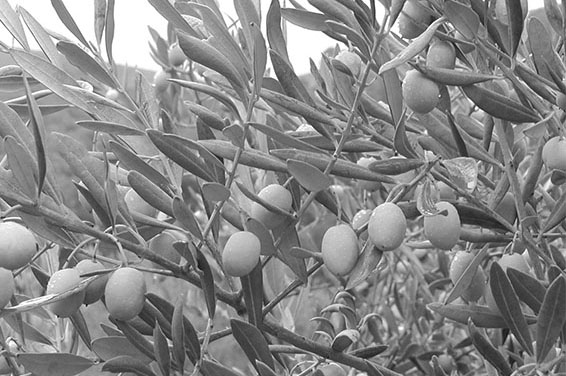
Olive Varieties
Browse our selection of oil, table and dual purpose olive varieties. We specialize in custom propagation for your orchard planting needs but inquire about current availability.
-
Aglandau
Aglandau
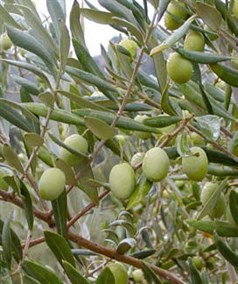
Origin: France
Purpose: Dual
Cold tolerance: High
Self sterile
Productivity: Medium
Start of bearing: Intermediate
Oil content: MediumGrowth: Aglandau is a tree of medium vigor with a spreading crown. It is usually referred to as self sterile; Picholine and Cayon are pollinizers. It is considered a hardy variety, with good cold tolerance but only moderate tolerance for drought. It tends to alternate bearing and should be managed with this in mind. Appropriate pruning, irrigation and fertilization will help to minimize this tendency.
Pests: Aglandau is resistant to verticillium wilt and olive knot. It is moderately susceptible to leaf spot, black scale and olive fly.
Fruit: Aglandau is used mostly for oil, but is also a good pickling olive. It is clingstone and medium in size. It yields a high quantity of excellent quality oil with good keeping qualities.
Harvest: Experience with single varietal Aglandau in California is very limited. This variety can be quite bitter and is probably better suited to harvest when it is fairly ripe.
-
Arbequina
Arbequina
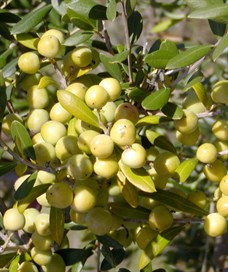
Origin: Spain
Purpose: Oil
Cold tolerance: High
Self fertile
Productivity: High
Start of bearing: Very Early
Ripening: Early
Oil content: HighGrowth: Arbequina is a low-vigor variety with a spreading, somewhat droopy growth habit. Because of its early bearing and low vigor, it is the mainstay of most super-high-density plantings; there is more newly planted California acreage in Arbequina than any other oil variety. When not grown in a hedgerow configuration, Arbequina will develop a medium sized, spreading canopy. It is considered cold tolerant and adapted to a wide range of soil types. It is also moderately drought and salinity tolerant. It is considered self-fertile, but the presence of a pollinizer can increase yields.
Pests: Arbequina is considered tolerant of leaf spot by some sources, but in California super-high-density plantings peacock spot can be a significant problem. Wider spacing and better air circulation will likely reduce the incidence of foliar disease. Conversely, the literature lists Arbequina as susceptible to olive fruit fly. In general, California’s experience with the variety has been the opposite: Arbequina tends to be one of the varieties less susceptible to olive fly damage. It has low tolerance to black scale. Arbequina is generally cited as moderately susceptible to olive knot and susceptible to verticillium.
Oil: The oil produced by this variety is abundant and of good quality. Low polyphenol levels limit the shelf life of the oil, but also result in a milder, fruity flavor that is popular with many consumers. The flavor is characterized by floral, almond and tropical notes, with varying levels of nutty and grassiness depending on the harvest maturity. The soft, sweet character of Arbequina makes it an excellent base oil for blending.
Harvest: An early ripener, Arbequina is usually the first oil variety harvested in California. The fruit does not turn black until it is very ripe, so at harvest is it normally yellowish green with some faint blush. The removal force of Arbequina is medium, but its small size makes it difficult to harvest with a shaker. Super-high-density production uses an over-the-row harvester with beater bars to facilitate fruit removal.
-
Arbosana i-43
Arbosana i-43
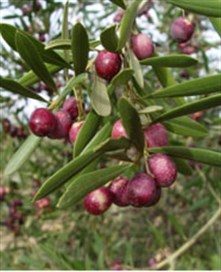
Origin: Spain
Purpose: Oil
Cold tolerance: Medium low
Self fertile
Productivity: High and regular
Start of bearing: Early
Ripening: Medium late
Oil content: HighGrowth: This is an IRTA (Institute of Research and Technology for Agriculture and Food) selection of the Arbosana variety which originated in the northeast of Spain. Arbosana is a small-fruited variety with a compact, open growth habit. The fruit is born in clusters. It is found in California almost exclusively in super-high-density plantings, where it is a favorite of orchard managers because of its very low vigor. It is sensitive to cold and drought.
Pests: The i-43 clone of Arbosana shows resistence to leaf spot. Arbosana is susceptible to olive knot.
Oil: Arbosana produces a medium yield of excellent quality oil. Polyphenols are moderate and the oil is well-balanced with complex fruitiness.
Harvest: Arbosana ripens several weeks later than Arbequina. It has low attachment force which makes it suitable for mechanical harvesting but the clusters of fruit can require special attention in cleaning at the mill.
-
Ascolana
Ascolano (aka Ascolano)
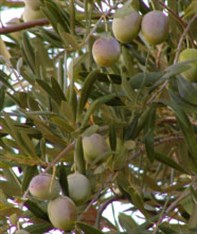
Origin: Italy
Purpose: Dual
Cold tolerance: High
Self sterile
Productivity: Medium
Start of bearing: Early
Oil content: MediumGrowth: Ascolana is a vigorous tree with an erect growth habit and dense canopy. It requires a pollinizer: Itrana, Santa Caterina, Giaraffa, Rosciola, Morchiaio, Manzanillo, Leccino, Pendolino, Frantoio and Mission are all cited. Its tolerance to cold is high. Bearing is intermediate, and tends to alternate.
Pests: Like many varieties with large, tender fruit, Ascolana is notoriously attractive to the olive fly. Growers of this variety will need to be vigilant about controlling this pest. Its resistance to olive knot and leaf spot is high but it is considered susceptible to verticillium.
Fruit: This variety was originally planted in California for table olive production. It fell out of favor as a table variety because of its tendency to bruise. It has enjoyed a renaissance in recent years as an oil variety. Although it has only a moderate amount of oil, the quality is excellent. It has a very distinctive varietal character, with stone fruit and tropical notes, that is much in demand in California both as a mono-cultivar and as a blending oil.
Harvest: Ascolana is an early ripening variety. It can be harvested at various maturities, ranging from a green style with pronounced bitterness and pungency to a very tropical ripe-flavored oil. Even a small percentage of Ascolana in a blend will lend a lot of complexity to the flavor profile.
-
Cerignola
Cerignola (aka Bella di Cerignola, Grossa di Spagna)
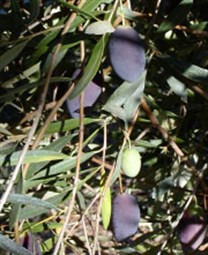
Origin: Italy
Purpose: Table
Cold tolerance: Low
Partially self-compatible
Productivity: Medium, alternate
Start of bearing: Early
Ripening: Early
Oil content: LowGrowth: Cerignola is a tree of medium to low vigor with a growth habit that is described as erect or spreading. It has a low tolerance to cold, and is susceptible to drought. Cerignola is considered a demanding variety, requiring good cultural practices. This cultivar is partially self-compatible, but is often grown with pollinizers such as Mele, San Agostino and Termite di Bitetto. Leccino, Frantoio and Pendolino are also purported to be pollinizers. It is from the Puglia region of Italy. The “Jumbo Kalamata” of Australia is thought to be this variety.
Pests: Cerignola is sensitive to olive knot and peacock spot. It is considered highly susceptible to sooty molds.
Fruit: This cultivar is valued primarily for the size of its fruit. It is usually used for green olives in brine, but can also be used for black table olives. The flesh is fibrous and clings to the pit. There is a high ratio of flesh to pit.
Harvest: The attachment force of Cerignola is high and the fruit ripens early.
-
Chemlali
Chemlali
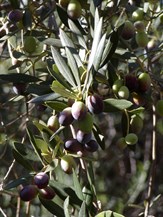
Origin: Tunisia
Purpose: Oil
Cold tolerance: Medium
Self fertile
Productivity: High-alternate
Start of bearing: Intermediate
Ripening: Late
Oil content: HighGrowth: Chemlali is a high vigor tree with a dense spreading growth habit. It flowers early and produces a lot of pollen. Chemlali is drought resistant and moderately salinity resistant. Chemlali is the most widely planted variety in Tunisia.
Pests: Susceptibility to olive knot and olive leaf spot is high, but Chemlali has some resistance to verticillium.
Oil: The oil yield of this cultivar is high, although extraction can be difficult. There is little experience with the cultivar in California, but some excellent Chemlali oils are being produced in Tunisia and elsewhere.
Harvest: The fruit ripens late. Research in Tunisia suggests that the optimal harvest maturity index for quality is between 2.5 and 3.5, corresponding to the period from the end of November to the middle of December in Tunisia.
-
Columella
Columella (aka Colombale, Columello)
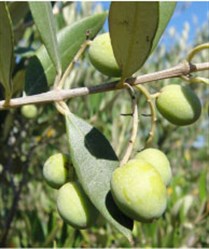
Origin: France
Purpose: Oil
Cold tolerance: Medium
Productivity: Intermediate, alternate
Ripening: Medium early
Oil content: HighGrowth: Columella is a medium vigor tree. Its resistance to cold is rated in the literature from low to high. California data from a freeze in 1990 indicates good to medium cold tolerance. The productivity is listed as intermediate and alternate. Aglandau is said to be the traditional pollinizer for Columella but no reference to its fertility needs was found in the literature; Cayon and Pendolino are also reported as pollinizers. According to anecdotal information in California, it has good consistent yields in a location that is warm, somewhat protected and surrounded by many other cultivars. In a windier and cooler location, also with other cultivars nearby, the yields are lighter.
Pests: Columella is moderately susceptible to peacock spot and highly susceptible to verticillium.
Oil: When harvested green, Columella yields an aromatic, sweet and fruity oil with a good balance of bitter and pungent notes. Grassy and herbaceous flavors are enhanced by tropical and floral flavors.
Harvest: Fruit ripening is medium early. Columella is unusual among the French cultivars normally grown in California in its suitability for early harvest. The fruit is fragile and prone to bruising; it can be damaged by windy storms as it is ripening, so an early harvest is advisable.
-
Coratina
Coratina
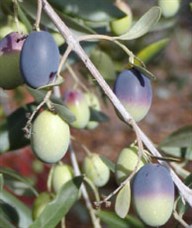
Origin: Italy
Purpose: Oil
Cold tolerance: High
Self sterile
Productivity: High
Start of bearing: Early
Ripening: Late
Oil content: HighGrowth: Coratina is a tree of medium vigor and a dense, spreading growth habit. It accounts for the majority of oil olive acreage in Puglia, its area of origin, which is the largest olive producing region in Italy. It is very adaptable and tolerant of cold and moderately tolerant of drought and salinity. In Puglia, a variety called Cellina di Nardo is used as a pollinizer. In California, it is most often planted with assorted Italian varieties which serve as pollinizers.
Pests: This variety is moderately susceptible to olive knot and verticillium. Its sensitivity to foliar disease appears to be moderate. It is considered susceptible to scale insects, sooty mold and olive fly.
Oil: Coratina’s popularity is well founded. It gives a high yield of good quality oil which is easily extracted. The oil is exceptionally high in polyphenols, resulting in excellent stability. The high polyphenols also account for very high bitterness when it is harvested green. Traditionally, Italian Coratina is harvested when quite ripe, resulting in a very fruity oil with floral and cherry notes and moderate bitterness and pungency. California Coratina harvested at the same time as the Tuscan varieties, will produce an aggressively bitter oil. Because of the potential for high bitterness, some producers prefer to grind this variety on a stone mill. The high polyphenol nature of Coratina can make it a valuable addition to a blend when improved stability is desired.
Harvest: Coratina is a good choice only for growers who can expect a long growing season. It needs time and heat to ripen if it is to produce the best oil. Cool, coastal locations and sites that are prone to early frost are probably not well-suited to this variety.
-
Frantoio
Frantoio (aka Razzo, Corregiolo)
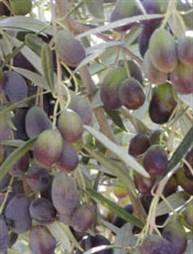
Origin: Italy
Purpose: Oil
Cold tolerance: Low
Self fertile
Productivity: High
Start of bearing: Early
Ripening: Late
Oil content: HighGrowth: Frantoio is a moderately vigorous tree with a spreading-drooping growth habit and medium-dense canopy. It is one of the main varieties in the classic Tuscan blend. Frantoio is highly and consistently productive, and very adaptable. It is quite cold sensitive, however, and can suffer frost damage while other varieties in the same orchard are unscathed. Frantoio is self fertile, but the yields increase with the presence of pollinizers. Pendolino is the most popular choice for a pollinizer, but Leccino and Maurino are suitable as well. Frantoio is popular world-wide, with significant acreage in Australia, Argentina and Chile.
Pests: Frantoio is susceptible to peacock spot, scale insects and olive knot. It is also moderately susceptible to olive fly and to verticillium wilt. Its vulnerability to frost damage will make it more susceptible to olive knot infection during the winter, so preventative applications of copper are advisable in the event of cold injury.
Oil: Frantoio is one of the world’s premier oil varieties. The oil yield is high and it is easily extracted; the variety was named after the place where oil is made for a good reason! Frantoio is prized for its fruity character, and is popular both in blends and as a single varietal oil. Floral, almond, green apple, fresh-cut grass and artichoke notes are characteristic of Frantoio, and it has an excellent balance of fruitiness, bitterness and pungency.
Harvest: The ripening of Frantoio is late and phased. Most olive oil producers harvest when the fruit is about 50/50 green and purple. The fruit removal force is moderate, and it is considered a suitable variety for shaker harvest.
-
Hojiblanca
Hojiblanca
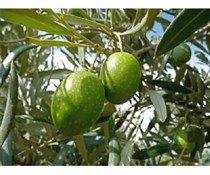
Origin: Spain
Purpose: Dual
Cold tolerance: Moderately high
Self sterile
Productivity: High, alternate
Start of bearing: Intermediate to late
Ripening: Late
Oil content: LowGrowth: Hojiblanca is a medium-high vigor variety with and erect growth habit and a medium density canopy. It is considered hardy because it is both drought resistent and relatively cold tolerant. In terms of acres planted it is the third most common variety in Spain. It is tolerant of calcareous soils and moderately tolerant of salinity.
Pests: Hojiblance is considered susceptible to olive knot, olive leaf spot, anthracnose and verticillium wilt.
Oil: Hojiblanca has a low yield of very high quality oil. It is highly aromatic but low in polyphenols producing an oil with excellent fruitiness and low bitterness and pungency. Traditionally, it is often used in a blend in Southern Spain with Picual and Picudo. Because of its firm texture, it is popular for making “California Black Ripe” style olives.
Harvest: Hojiblanca has high attachment force, making it a challenge for mechanical harvesting. It ripens late.
-
Itrana
Itrana
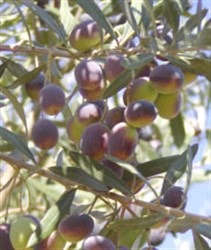
Origin: Italy
Purpose: Dual
Cold tolerance: High
Self sterile
Productivity: High
Start of bearing: Intermediate
Ripening: Late
Oil content: MediumGrowth: Itrana is a vigorous tree with an erect shape. It is cold tolerant. Its outstanding form and fast growth make it particularly well suited to landscape applications. Itrana is self sterile and should be planted with pollinizers such as Leccino and Frantoio.
Pests: This cultivar is resistant to olive knot and leaf spot.
Fruit: Itrana is used both for the production of table olives and for oil; its yields are generally good and constant. It is most commonly pickled when black; the fruit is large and freestone. It gives a medium yield of oil that is highly regarded for its fruity character.
Harvest: This cultivar is late to ripen. There is very little experience with it as a single varietal oil in California; it has typically been used in field blends.
-
Kalamon (Kalamata)
Kalamon
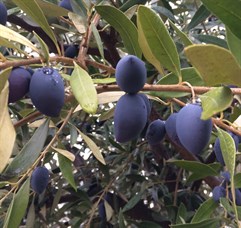
(aka Kalamata)Origin: Greece
Purpose: Dual
Cold tolerance: Medium
Self fertile
Productivity: High, alternate
Start of bearing: Intermediate
Ripening: Late
Oil content: MediumGrowth: The variety Kalamon is used to make Kalamata-style table olives. The name “Kalamata” has Protected Designation of Origin (PDO) protection in the EU so the name is only to be used for olives produced in the Kalamata region of the Peloponnese, Greece. Kalamata PDO olive oil also comes from this region but is made with Koroneiki variety olives, not Kalamon.
Kalamon trees have a very distinctive appearance because of their large twisting leaves. The tree is upright in growth habit, and vigorous. It is moderately resistant to cold and resistant to salinity. Its rooting ability is low so it is most often grafted onto another variety rootstock.
Pests: Kalamon is moderately sensitive to peacock spot and verticillium wilt, but resistant to olive knot. It is susceptible to various scale insects.
Fruit: Although it is most often used for table olive production, Kalamon produces a moderate yield of excellent quality oil of relatively high polyphenol content. The flesh to pit ratio is high.
Harvest: It ripens late and is usually cured as a black olive. Kalamon is always harvested by hand for pickling.
-
Koroneiki
Koroneiki
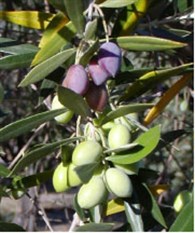
Origin: Greece
Purpose: Oil
Cold tolerance: Low
Partially self-fertile
Productivity: High
Start of bearing: Early
Ripening: Medium-late
Oil content: HighGrowth: Koroneiki is the main oil olive variety from Greece. It is widely planted around the world, and is one of the cultivars used in super-high-density production systems. It is considered tolerant of drought, but sensitive to cold. It is listed as self-fruitful by most sources, but like most olives, yields will be higher and more reliable with cross-pollination. Mastoidis is the traditional pollinizer in Crete. Koroneiki is a medium vigor tree, with a compact, open growth habit and the fruit is very small.
Pests: Koroneiki is considered tolerant of leaf spot but sensitive to olive knot. Some sources list it as moderately tolerant of verticillium wilt.
Oil: Koroneiki produces high yields of very good quality oil. The polyphenol level and oleic acid content are both high, contributing to excellent stability. When harvested early, the variety produces oil of pronounced bitterness and pungency, with characteristic green banana and herbaceous notes. As it ripens, tropical/ripe banana and floral notes emerge.
Harvest: In super-high-density plantings in California, Koroneiki is often harvested between the Arbequina and the Arbosana. It has a very high fruit attachment force which, combined with its small size, makes it difficult to harvest, especially by shaking. Over-the-row harvesters with beater bars are used to harvest SHD plantings of Koroneiki.
-
Leccino
Leccino
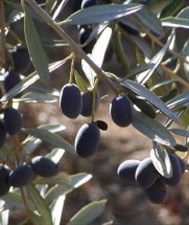
Origin: Italy
Purpose: Oil
Cold tolerance: High
Self sterile
Productivity: High
Start of bearing: Early
Ripening: Early
Oil content: MediumGrowth: Leccino is a vigorous cultivar with a dense, slightly drooping growth habit and high adaptability. It is self incompatible; the common pollinizers are Pendolino, Frantoio, Maurino and Moraiolo. It is the first variety to come into bearing in most California Tuscan field blends, and is usually the earliest to ripen. It has shown good tolerance of low temperatures. Leccino tends slightly to alternate bearing, but this can be managed with cultural practices.
Pests: Leccino is fairly resistant to olive knot and peacock spot, but is sensitive to verticillium. It is considered highly susceptible to black scale and sooty mold, but only moderately susceptible to the olive fly.
Oil: The oil content of Leccino is cited as low, medium and high by different sources, with the majority falling in the medium-high vicinity. The oil is sweet, fruity and characterized by cinnamon-spice notes. It is a popular choice for olio nuovo releases because of its early maturation and high palatability when first pressed.
Harvest: Leccino is an early and simultaneously ripening variety. The skin of Leccino turns black very early, but the flesh remains green for a deceptively long time. It has moderate removal force, similar to Frantoio, but there is little information available about its suitability to mechanical harvest.
-
Lucques
Lucques
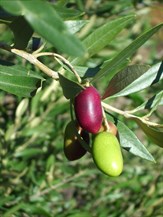
Origin: France
Purpose: Table
Cold tolerance: Medium
Self sterile
Productivity: Medium-high, alternate
Start of bearing: Intermediate-late
Ripening: Medium-early
Oil content: Medium-lowGrowth: This is a medium vigor variety with an erect growth habit. The canopy is dense. Some references call Lucques cold sensitive, others say it is cold tolerant. It is regarded as demanding to grow and drought susceptible. Flowering is very early.
Pests: Lucques is sensitive to verticillium wilt, scale, sooty mold and olive fly. It is considered relatively resistant to peacock spot.
Fruit: The Lucques fruit is freestone and used for making green olives that are highly regarded for their sensory characteristics. It can be used for oil production but is purported to be difficult to extract.
-
Manzanillo
Manzanillo
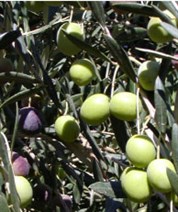
Origin: Spain
Purpose: Dual
Cold Tolerance: Medium
Self sterile
Productivity: High, alternate
Start of bearing: Early
Ripening: Early
Oil content: MediumGrowth: Manzanillo is low to moderate in vigor, with a spreading growth habit and medium density. It is the most widely planted table olive variety in the world and accounts for the majority of the table olive production in California. It tends to alternate bearing, but this can be ameliorated with appropriate cultural practices. In Spain it is treated as self fertile, but in other countries yields are improved by the presence of pollinizers. Mission and Ascolano are not suitable pollinizers for Manzanillo. It is moderately tolerant to both cold and drought.
Pests: Manzanillo is very susceptible to verticillium wilt and olive knot. Preventative application of a copper spray is advisable after episodes of frost injury; bark cracks caused by cold are an ideal entry point for the olive knot bacteria. Manzanillo is also attractive to olive fly. Its susceptibility to scale insects and peacock spot is moderate.
Fruit: The fruit of the Manzanillo is round and freestone, with a high ratio of flesh to pit. It is harvested green for curing as “California black ripe” style olives, but can also be picked when changing color. Manzanillo can also make a good oil with distinctive varietal character. The oil is notoriously difficult to extract, however, particularly when the water content of the fruit is high. The oil obtained from early harvest Manzanillo is usually regarded as superior to that from riper fruit, which is fortunate because ripe Manzanillo is also harder to work with. It results in a wet sticky paste that forms emulsions easily and hinders the extraction of the oil.
Harvest: The removal force of Manzanillo is high. Traditionally it is harvested by hand for table olives, but recently developed mechanical harvesters are showing some promise.
-
Maurino
Maurino
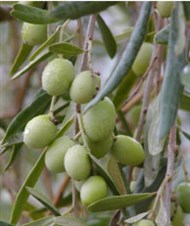
Origin: Italy
Purpose: Oil
Cold tolerance: Medium
Self sterile
Productivity: High, alternate
Start of bearing: Early
Ripening: Medium early
Oil content: Medium highGrowth: Maurino is a handsome tree of medium vigor with an erect growth habit. The literature cites its cold tolerance as moderate or high. It originated in the Lucca area of Tuscany, and is grown a lot in central Italy. It is popular as a pollinizer, producing large amounts of fertile pollen which is compatible with many cultivars. Maurino is often included in the “Tuscan blend.” Varieties mentioned as pollinizers for Maurino include Pendolino, Leccino, Moraiolo, Frantoio, Lazzero and Grappolo.
Pests: Maurino is considered resistant or moderately resistant to leaf spot. It is moderately susceptible to olive knot.
Oil: The oil content of Maurino is cited as being medium to very good, and the quality as good. Maurino is usually found in a Tuscan blend, but occasionally is made into a monocultivar oil.
Harvest: Fruit ripening is medium early and simultaneous.
-
Mission
Mission
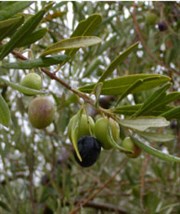
Origin: United States
Purpose: Dual
Cold tolerance: High
Self fertile
Productivity: High
Start of bearing: Intermediate
Ripening: Late
Oil content: HighGrowth: Mission is a vigorous variety with an erect growth habit. It is the oldest California variety. Originally from Spain, it spread up the state from Baja California with the establishment of the missions. Its popularity as a table variety has decreased in recent years, but it is a perennial favorite for oil production. It tends to alternate bearing, but this can be minimized somewhat with cultural practices. It is considered very tolerant of cold and salinity, and moderately tolerant of drought.
Pests: Mission is extremely susceptible to peacock spot; untreated street trees in coastal California are almost defoliated during years when the weather favors foliar disease. A consistent preventative program is important to manage the disease and minimize stress on the trees. Mission is also susceptible to verticillium wilt. It is moderately resistant to olive knot, however. It is susceptible to olive fly.
Fruit: This cultivar has a high yield of good quality oil. Aggressively bitter when it is harvested too green, the Mission olive is best harvested for oil when moderately mature. The oil has green notes of pine and mint, and a soft buttery ripe character. Very ripe Mission can be used to create a classic California style of oil usually called Late Harvest Mission. This popular oil has a buttery and tropical fruity quality. Mission is also a popular olive for flavored oils; processed with fresh citrus fruit, it makes a well-balanced flavored oil. Mission is also a good table cultivar. It is freestone and can be harvested green or ripe for a variety of different table olive styles.
Harvest: Mission has a medium removal force. Its upright growth habit makes is well suited to mechanical harvesting. It ripens late and is frequently harvested in the new year for late harvest style oils.
-
Moraiolo
Moraiolo
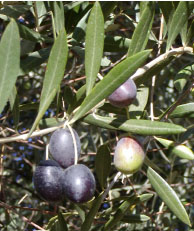
Origin: Italy
Purpose: Oil
Cold tolerance: Medium
Self sterile
Productivity: High, constant
Start of bearing: Early
Ripening: Medium early
Oil content: Medium highGrowth: Moraiolo originated in Tuscany but has been disseminated around Italy and elsewhere. It is a low to medium vigor tree with an upright growth habit. Its tolerance for cold is considered low by a majority of the sources, but medium and even high by some. This is a popular and widespread variety, and numerous ecotypes have been identified. It is self-sterile; pollinizers include Pendolino, Maurino, Lazzero and Rosino; it is reportedly incompatible with Leccino. In the literature it is said to come into bearing early, but in California it seems to be slower that most of the other Tuscans to reach full production. It has high, constant productivity.
Pests: Moraiolo is considered susceptible or highly susceptible to leaf spot. It is also susceptible to olive knot and verticillium.
Oil: This cultivar is prized for its high content of excellent oil which is easily extracted. Moraiolo is popular as a monocultivar and also as a constituent of a Tuscan blend. The oil is very fruity and complex, with pronounced bitter and pungent notes.
Harvest: Fruit ripening is intermediate and phased.
-
Pendolino
Pendolino
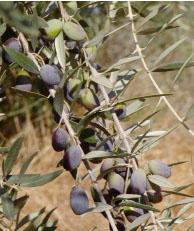
Origin: Italy
Purpose: Oil
Cold tolerance: Medium
Self sterile
Productivity: High
Start of bearing: Early
Ripening: Intermediate
Oil content: MediumGrowth: Pendolino is a tree of moderate vigor and a dense drooping growth habit. It flowers early and profusely, and the bloom period is long, making it an ideal pollinizer. This is its primary role in a classic Tuscan field blend. It is self-incompatible, however, and relies on the pollen of its neighboring trees (especially Leccino and Maurino). It is commonly planted at a rate of about 10% when used as a pollenizer. It is fairly tolerant of cold temperatures.
Pests: Pendolino is sensitive to olive knot and peacock spot. It is considered highly susceptible to verticillium and sooty molds. It is of only moderate interest to the olive fly, however.
Oil: Although its primary function is as a pollinizer, Pendolino produces a moderate amount of good quality oil. The oil is seldom produced as a single varietal, but is pleasant with good balance and sweetness.
Harvest: Pendolino has low attachment force, but its low fruit weight and pendulous growth habit makes it difficult to harvest mechanically. It matures mid season.
-
Picual
Picual
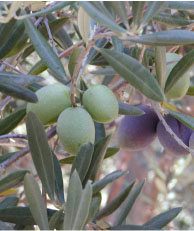
Origin: Spain
Purpose: Oil
Cold tolerance: High
Partially self fertile
Productivity: High
Start of bearing: Early
Ripening: Early
Oil content: HighGrowth: Picual is a tree of medium vigor and a spreading growth habit. It is cold tolerant and highly adaptable. It is considered tolerant of salinity and excess soil moisture, but sensitive to drought and calcareous soils. Picual is the most important variety in Spain, accounting for more than 1,700,000 acres.
Pests: Picual is resistant to olive knot. It is, however, susceptible to leaf spot and verticillium wilt.
Oil: This variety has a high, constant production of very stable oil. Picual has a very distinctive varietal flavor which is famously “catty” when it is overripe. When harvested at the proper maturity and processed with speed and care, Picual yields a superb quality oil. A distinctly tomato leaf note with rich dark undertones characterizes the variety. Picual oil has a very high polyphenol and oleic acid content. It is an excellent addition to blends where better shelf life and a more complex flavor profile are desired.
Harvest: Picual has a very low attachment force which makes it easy to harvest. It is ideally suited to trunk or canopy shakers. It ripens early, making it a good choice for areas where there is a danger of early frost.
-
Taggiasca
Taggiasca
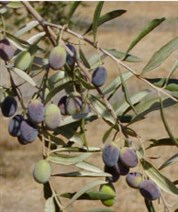
Origin: Italy
Purpose: Oil
Cold tolerance: Low
Partially self fertile
Productivity: High
Start of bearing: Intermediate
Ripening: Late
Oil content: HighGrowth: Taggiasca is a vigorous variety with a drooping growth habit. It is the dominant variety in the Italian region of Liguria. The cultivar adapts well to both coastal and hilly terrain. It is considered
sensitive to cold, particularly in the spring, and also to drought and wind.Pests: Taggiasca is susceptible to olive knot and leaf spot.
Oil: The productivity of Taggiasca is high and constant. The fruit has a high content of easily extracted oil. Traditionally, this variety is harvested late when it is very ripe, and it yields the fruity and delicate oil characteristic of Liguria. Olive growers in California have been experimenting with different harvest maturities, however, and are producing a greener style oil with this cultivar. The quality of the oil is
excellent, and it has been a consistent favorite in competitions. The Taggiascas of California are
generally characterized by floral, herbaceous notes.Harvest: Taggiasca is considered a late-ripening variety. It is similar to Frantoio in its maturation
schedule. Since much of the traditional acreage in Taggiasca is very hilly, it is almost always hand
harvested in its home range.
